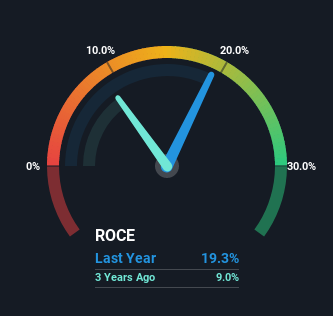- United States
- /
- Tech Hardware
- /
- NasdaqGS:SMCI
Super Micro Computer (NASDAQ:SMCI) Is Doing The Right Things To Multiply Its Share Price

Did you know there are some financial metrics that can provide clues of a potential multi-bagger? One common approach is to try and find a company with returns on capital employed (ROCE) that are increasing, in conjunction with a growing amount of capital employed. This shows us that it's a compounding machine, able to continually reinvest its earnings back into the business and generate higher returns. Speaking of which, we noticed some great changes in Super Micro Computer's (NASDAQ:SMCI) returns on capital, so let's have a look.
Understanding Return On Capital Employed (ROCE)
If you haven't worked with ROCE before, it measures the 'return' (pre-tax profit) a company generates from capital employed in its business. To calculate this metric for Super Micro Computer, this is the formula:
Return on Capital Employed = Earnings Before Interest and Tax (EBIT) ÷ (Total Assets - Current Liabilities)
0.19 = US$335m ÷ (US$3.2b - US$1.5b) (Based on the trailing twelve months to June 2022).
Therefore, Super Micro Computer has an ROCE of 19%. In absolute terms, that's a satisfactory return, but compared to the Tech industry average of 10% it's much better.
View our latest analysis for Super Micro Computer

Above you can see how the current ROCE for Super Micro Computer compares to its prior returns on capital, but there's only so much you can tell from the past. If you'd like, you can check out the forecasts from the analysts covering Super Micro Computer here for free.
What Does the ROCE Trend For Super Micro Computer Tell Us?
Investors would be pleased with what's happening at Super Micro Computer. The numbers show that in the last five years, the returns generated on capital employed have grown considerably to 19%. The company is effectively making more money per dollar of capital used, and it's worth noting that the amount of capital has increased too, by 106%. This can indicate that there's plenty of opportunities to invest capital internally and at ever higher rates, a combination that's common among multi-baggers.
On a separate but related note, it's important to know that Super Micro Computer has a current liabilities to total assets ratio of 46%, which we'd consider pretty high. This effectively means that suppliers (or short-term creditors) are funding a large portion of the business, so just be aware that this can introduce some elements of risk. Ideally we'd like to see this reduce as that would mean fewer obligations bearing risks.
What We Can Learn From Super Micro Computer's ROCE
A company that is growing its returns on capital and can consistently reinvest in itself is a highly sought after trait, and that's what Super Micro Computer has. And a remarkable 159% total return over the last five years tells us that investors are expecting more good things to come in the future. Therefore, we think it would be worth your time to check if these trends are going to continue.
Since virtually every company faces some risks, it's worth knowing what they are, and we've spotted 2 warning signs for Super Micro Computer (of which 1 shouldn't be ignored!) that you should know about.
While Super Micro Computer isn't earning the highest return, check out this free list of companies that are earning high returns on equity with solid balance sheets.
New: Manage All Your Stock Portfolios in One Place
We've created the ultimate portfolio companion for stock investors, and it's free.
• Connect an unlimited number of Portfolios and see your total in one currency
• Be alerted to new Warning Signs or Risks via email or mobile
• Track the Fair Value of your stocks
Have feedback on this article? Concerned about the content? Get in touch with us directly. Alternatively, email editorial-team (at) simplywallst.com.
This article by Simply Wall St is general in nature. We provide commentary based on historical data and analyst forecasts only using an unbiased methodology and our articles are not intended to be financial advice. It does not constitute a recommendation to buy or sell any stock, and does not take account of your objectives, or your financial situation. We aim to bring you long-term focused analysis driven by fundamental data. Note that our analysis may not factor in the latest price-sensitive company announcements or qualitative material. Simply Wall St has no position in any stocks mentioned.
About NasdaqGS:SMCI
Super Micro Computer
Develops and sells high performance server and storage solutions based on modular and open architecture in the United States, Europe, Asia, and internationally.
Exceptional growth potential and undervalued.
Similar Companies
Market Insights
Community Narratives



